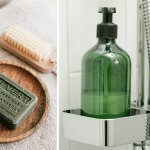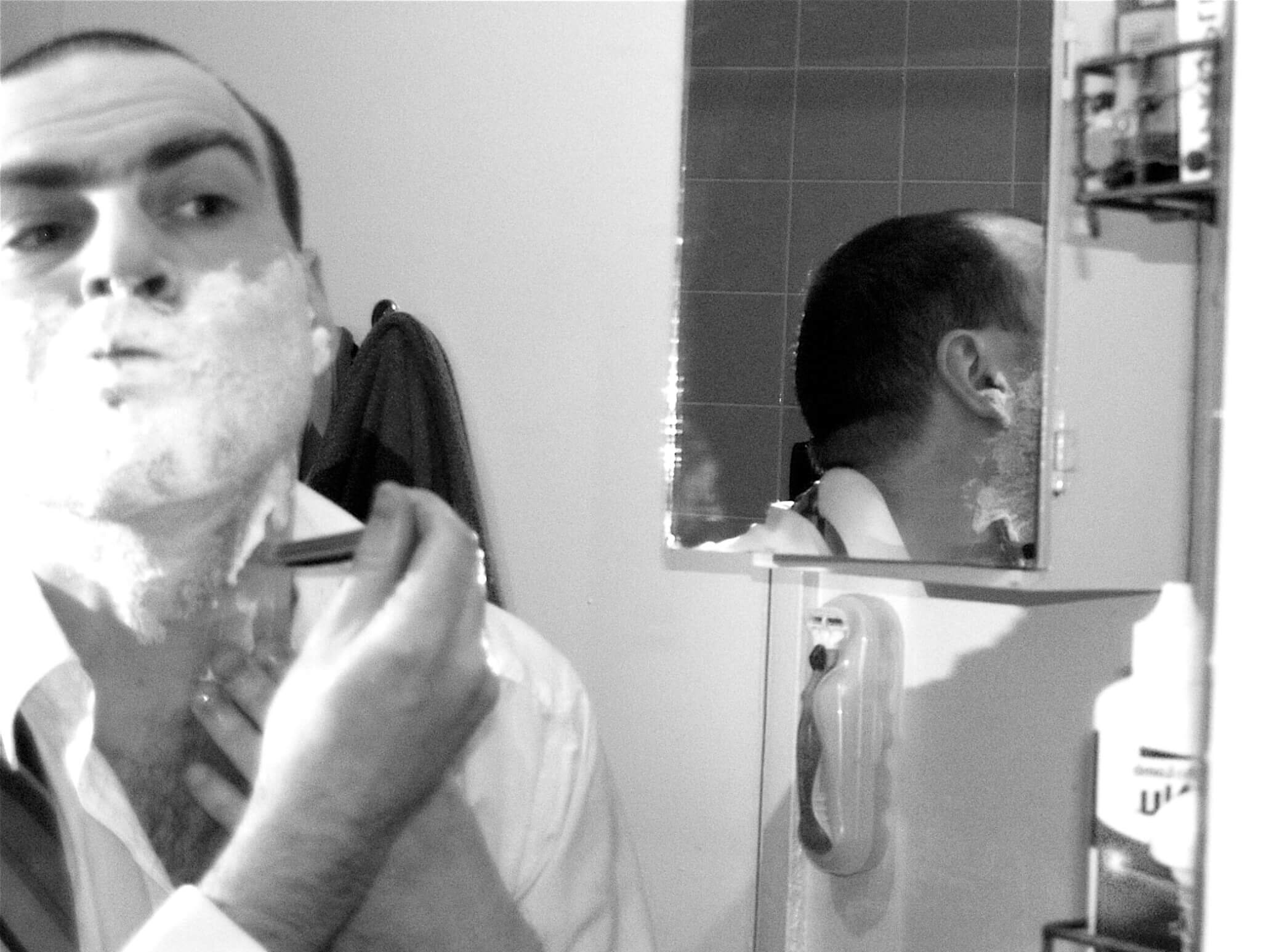 Source: saintbob, CC BY 2.0, via Wikimedia Commons
Source: saintbob, CC BY 2.0, via Wikimedia CommonsOut of shaving cream, shampoo, or deodorant? Discover what to use instead—grooming substitutes that work in a pinch.
You may have forgotten to pack it while traveling, or maybe you’ve simply run out. This isn’t about ideal alternatives to your usual grooming products, but what you could use in a pinch if they’re not at hand.
It’s about improvisation and resourcefulness. Maybe you’ll find just the thing in your kitchen cupboard. And quite often, personal care items you already have can double up for another use.
Working systematically from head to toe, let’s look at the possibilites.
Grooming Substitutes for Hair Care
Shampoo
None of our alternatives are kind to dry hair, so ask yourself: does it truly need washing today, or can it wait?
On the other hand, there is such a thing as co-washing, which means skipping shampoo and using conditioner instead.
Otherwise, body wash is mild and usually pH-balanced. It won’t help dry hair, but it can’t harm it either.
Used sparingly, dish soap mimics clarifying shampoo. It cuts grease and removes buildup, leaving hair lighter and more voluminous. But if you cover grays, think twice—it may fade the dye.
Liquid hand soap and bar soap are drying and disrupt the hair’s pH balance. Nevertheless, back in the days when shampoo was considered a nonessential luxury, a bar of soap was the only grooming item many men owned, whether for bathing, shaving, or washing their hair.
Conditioner
Having applied one of the drying shampoo alternatives above, you’ll need a conditioner to prevent further dehydration.
This is a slightly acidic product designed to smooth the hair cuticle, lock in moisture, and restore shine.
For a similar effect, dilute white or apple cider vinegar 1:5 with water and rinse after washing. The acidity helps seal the cuticle. Don’t worry about the smell; it dissipates quickly.
If vinegar is unavailable, think in terms of manageability rather than cuticle closure. Rub less than a pea-sized amount of face cream, body lotion, or hand cream between your palms and work it through your hair. Focus on the ends, avoiding the scalp. It won’t smooth the cuticle, but it can soften and tame dry, wiry hair.
To replace lost protein in bleached or parched hair, apply a beaten egg from root to tip. Leave for 20–30 minutes, rinse thoroughly, and finish with diluted vinegar to seal the cuticle.
Dry Shampoo
For oily hair, dry shampoo can stand in for regular shampoo and conditioner, but what if you don’t have that either? Here are a few substitutes. Choose with care.
- Cornstarch or arrowroot powder: These absorb oil without disrupting the scalp’s pH. Apply sparingly to the roots, wait a few minutes, then brush through. At a pinch, you could also use body or barber powder.
- Unsweetened cocoa powder: For darker hair, this helps avoid a powdery cast. It adds texture and absorbs oil but may leave a faint scent. Mix 1:1 with cornstarch or arrowroot.
- Baking soda: Often recommended, but not ideal. Being highly alkaline, it can irritate the scalp, disrupt pH balance, and damage the hair cuticle. Use sparingly and only if nothing else is available. Leave on for a few minutes, then brush out.
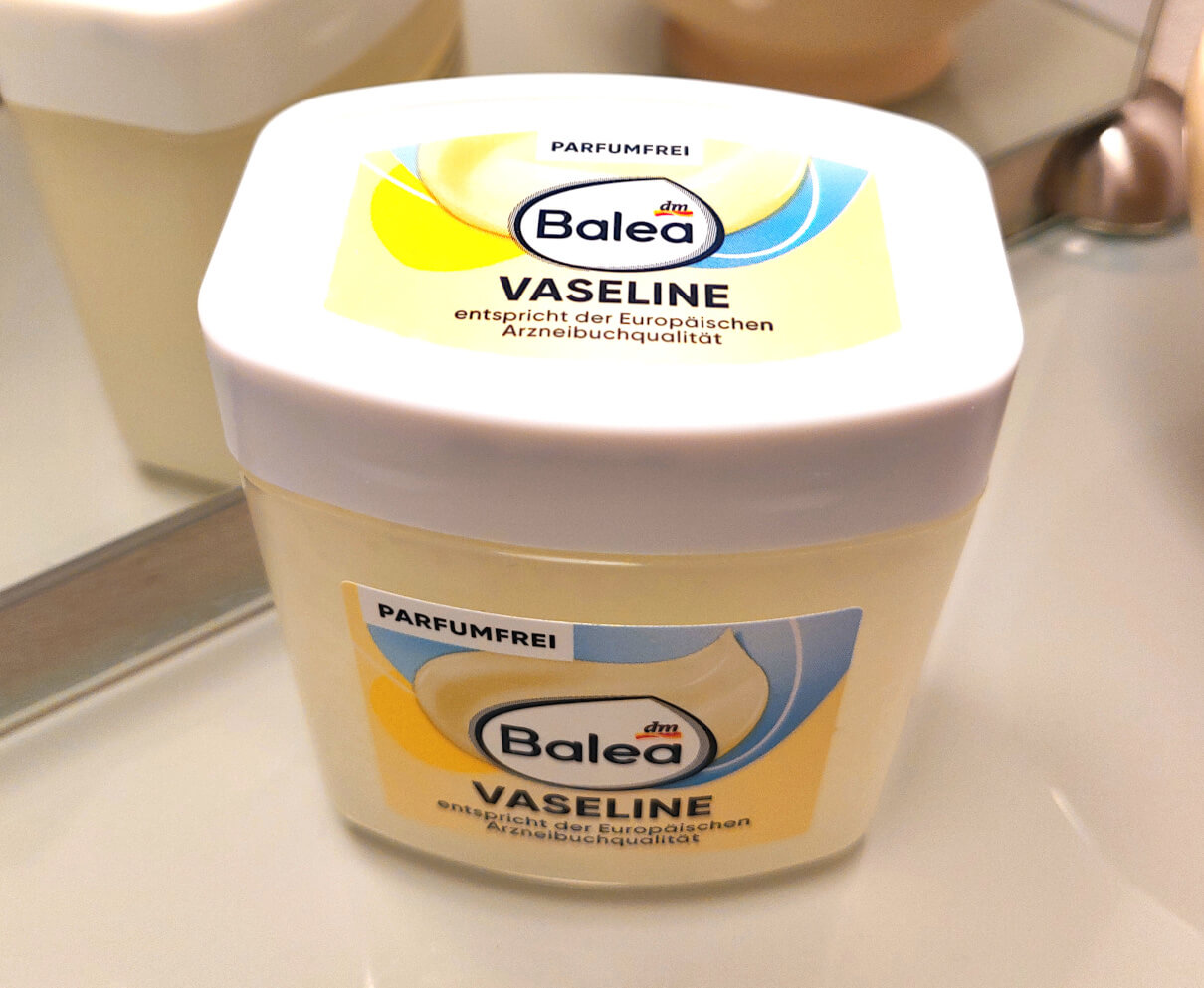
Grooming Substitutes for Facial Care
What to Use Instead of Shaving Cream
The choice shaving cream substitutes is surprisingly broad. You need something that creates a buffer between the skin and the razor, minimizing friction and the risk of cuts and irritation.
If you own a shaving brush, use bar soap as you would a puck. The lather won’t be as dense, but it will do the trick.
If you don’t have a shaving brush, work up a lather with a washcloth and your fingerstips. Or a clean, appropriately sized paintbrush would also do the trick. But avoid cosmetic brushes since these are too soft to lift the whiskers, which would lead to cutting if you use a safety razor.
For cartridge razors, no brush is necessary. Instead of your usual lubricant, apply body lotion, hair conditioner, or cooking oil.
Sunflower and canola are non-comedogenic, while olive and coconut oil may clog pores.
These can also be used in place of commercial pre-shave oils.
Of course, an electric razor is the perfect substitute; it works without shaving cream, razor blades, or a shaving brush.
For a smoother shave, apply a pre-electric product beforehand. This helps the razor glide smoothly, reducing irritation and providing a closer shave. If you don’t have a dedicated product, barber powder can do the same job.
Body powder and cornstarch also work, but may dull blades over time.
Facial Cleanser
Sunflower and canola oil are reliable facial cleansers, especially if you have dry skin.
Apply to a wet face, massage until the oil forms an emulsion, then rinse.
Alternatively, dissolve a tablespoon of baking soda in a basin of tepid water and splash over your face. This is ideal for acne-prone skin—no rinse required.
Toner/Aftershave
To tone and clear away shaving debris, swipe the face with a cotton pad soaked in diluted vinegar. Use white or apple cider vinegar at a 1:3 ratio with water.
Another alternative is witch hazel, which is mildly astringent and soothing. But make sure it’s alcohol-free.
In a pinch, both vinegar and witch hazel can work as a stand-alone cleanser.
Lip Balm
If you don’t have a lip balm at hand, protect with petroleum jelly. It seals in moisture and shields against wind and cold. But it doesn’t hydrate.
For dry, chapped lips, you’ll need extra care. Beef tallow balm protects and nourishes. Beard balm may do the same, but should be only lightly scented, if at all.
Sunscreen
Coconut and olive oil offer a sun protection factor (SPF) of 4–7, which is adequate in cooler climates but insufficient under intense sun. The same is true of aloe vera gel, in spite of a slightly higher SPF of 8-10.
Another option is zinc oxide paste. With an SPF of 20-50, depending on formulation, it offers optimal protection but leaves a chalky cast.
In hot weather, if proper sunscreen isn’t available, it may be better to cover up or stay indoors.
Grooming Substitutes for Facial Hair
Mustache Wax
Take a look at the below photo of my handlebar mustache: the ends are curled using Pritt Stick, a non-toxic, water-based glue that provides the same kind of hold as stiff-setting wax. In fact, I found it better, since it doesn’t flake or ball up.
Beard Balm
If you’re out of beard balm, beef tallow balm can nourish and protect. I don’t recommend petroleum jelly, since it attracts airborne particles and pollen; I know—I’ve tried it.
Otherwise, a vegetable oil from your kitchen will keep your beard or mustache soft and shiny.
Substitutes for Oral Hygiene
Toothpaste
Baking soda is a safe dentifrice endorsed by the Journal of the American Dental Association. I use it each morning and a xylitol toothpaste at night.
Due to its antibacterial properties, coconut oil is another option, or combine it with baking soda for added effect.
If nothing else is available, dissolve a teaspoon of salt in warm water and use as an antiseptic mouthwash after dry brushing.
Toothbrush
I’m afraid there’s no real substitute for a toothbrush when it comes to thorough cleaning.
Use either your index finger, the corner of a washcloth, or a paper towel.
For fresh breath, chew gum.
Grooming Substitutes for the Body
Bathing and Showering
If regular bar soap and body wash are not available, consider whether you really need a shower. Missing one day won’t cause you to stink. After all, until the mid-twentieth century, most of us bathed just once a week. For the rest of the time, a quick wash at the sink sufficed.
But in case you’re not convinced, here are a couple of viable options.
Bar Soap and Body Wash
In the Shower
In a pinch, dish soap can be diluted 1:1 with water and used as body wash—but it contains harsh surfactants that strip the skin. To soften its effect, add a small amount of hair conditioner to the diluted soap and shake vigorously.
Or mix with body lotion instead. Unlike conditioner, it won’t create a stable emulsion, but it may reduce dryness and leave a more hydrated feel. Adding both, of course, provides an emollient and moisturizer, which is even better.
Whichever option is available to you, use sparingly, rinse thoroughly, and follow with a hydrating product if needed.
Shampoo is another possibility. But over time, it can cause buildup and clog pores—the same would be true of hair conditioner used without a soap product. A better idea is liquid hand soap, which is non-occlusive and designed for skin.
In the Tub
Alternatively, soak for 10-20 minutes in a tub of warm water and 2 to 4 tablespoons of baking soda. There’s no need to rinse. Just pat dry and follow with a moisturizing product.
The Waterless Wash
When my new bathroom was being installed, I found myself without water for two days.
In such a situation, rub yourself down with wet wipes. If none are available, use a facial cleanser on high sweat and odor areas like the armpits, feet, and groin.
Failing that, hand sanitizer or rubbing alcohol applied to a washcloth works, but follow up with body lotion to prevent dryness.
Body Lotion
But body lotion is a product many men have never bought. We produce more sebum than women, so have less reason.
Instead, apply vegetable oil to damp skin.
Sunflower and canola absorb reasonably well and help restore moisture without clogging pores.
Avoid coconut oil on acne-prone areas; it can cause breakouts. The same is true of olive oil, which is heavier and less absorbant.
Hair conditioner—including leave-in formulas—is not a substitute for body lotion. These products are designed for hair, not skin, and may cause irritation, clogged pores, or residue buildup.
Armpits and Feet
Underarm Deodorant
Lemon juice or vinegar diluted with water 1:1 works well in a pinch if you have nothing better at hand. Both are acidic, thus neutralizing the alkaline environment in which bacteria thrive.
Baking soda and cornstarch mixed 1:1 absorb odor and perspiration. Body or barber powder can substitute cornstarch.
Or use zinc oxide paste. Just a pea-sized amount rubbed into the armpits offers all-day freshness. I’ve been doing this for years with excellent results.
Foot Deodorant
To combat foot odor, use the same baking soda and cornstarch mix described above.
Since the feet are less sensitive, you may add a drop or two of essential oil. Lavender and tea tree are masculine, skin-friendly, and antibacterial.
Grooming Substitutes That Work
Some of these grooming substitutes—like oils or baking soda—may earn a permanent place. But by and large, they’re practical responses that help us stay clean and presentable when we’ve been forgetful.
The main thing is that they work, even if they’re not ideal.
© 2025 J. Richardson
Related Posts
Disclaimer
The information provided by The Neat and Tidy Man (“we,” “us,” or “our”) on theneatandtidyman.com (the “site”) is for general informational purposes only. While we endeavor to keep the information up to date and correct, we make no representation or warranty of any kind, express or implied, regarding the completeness, accuracy, reliability, suitability, adequacy, validity, or availability of any information on the site. Under no circumstance shall we have any liability to you for any loss or damage of any kind incurred as a result of the use of the site or reliance on any information provided on the site. Your use of the site and your reliance on any information on the site is solely at your own risk.

